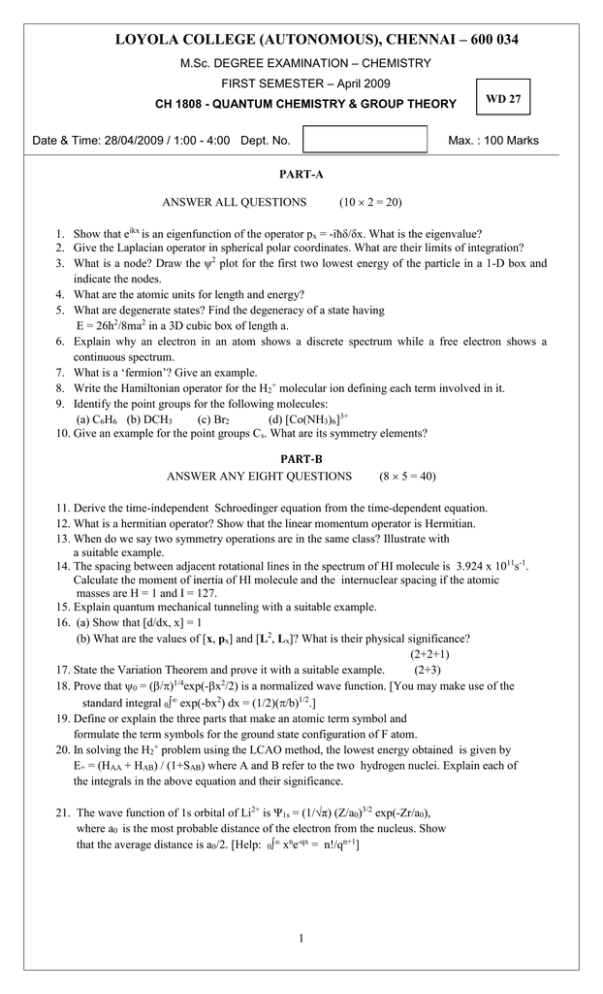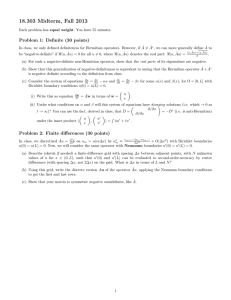LOYOLA COLLEGE (AUTONOMOUS), CHENNAI – 600 034
advertisement

LOYOLA COLLEGE (AUTONOMOUS), CHENNAI – 600 034 M.Sc. DEGREE EXAMINATION – CHEMISTRY FIRST SEMESTER – April 2009 CH 1808 - QUANTUM CHEMISTRY & GROUP THEORY Date & Time: 28/04/2009 / 1:00 - 4:00 Dept. No. WD 27 Max. : 100 Marks PART-A ANSWER ALL QUESTIONS (10 2 = 20) 1. Show that eikx is an eigenfunction of the operator px = -iħδ/δx. What is the eigenvalue? 2. Give the Laplacian operator in spherical polar coordinates. What are their limits of integration? 3. What is a node? Draw the ψ2 plot for the first two lowest energy of the particle in a 1-D box and indicate the nodes. 4. What are the atomic units for length and energy? 5. What are degenerate states? Find the degeneracy of a state having E = 26h2/8ma2 in a 3D cubic box of length a. 6. Explain why an electron in an atom shows a discrete spectrum while a free electron shows a continuous spectrum. 7. What is a ‘fermion’? Give an example. 8. Write the Hamiltonian operator for the H2+ molecular ion defining each term involved in it. 9. Identify the point groups for the following molecules: (a) C6H6 (b) DCH3 (c) Br2 (d) [Co(NH3)6]3+ 10. Give an example for the point groups Cs. What are its symmetry elements? PART-B ANSWER ANY EIGHT QUESTIONS (8 5 = 40) 11. Derive the time-independent Schroedinger equation from the time-dependent equation. 12. What is a hermitian operator? Show that the linear momentum operator is Hermitian. 13. When do we say two symmetry operations are in the same class? Illustrate with a suitable example. 14. The spacing between adjacent rotational lines in the spectrum of HI molecule is 3.924 x 1011s-1. Calculate the moment of inertia of HI molecule and the internuclear spacing if the atomic masses are H = 1 and I = 127. 15. Explain quantum mechanical tunneling with a suitable example. 16. (a) Show that [d/dx, x] = 1 (b) What are the values of [x, px] and [L2, Lx]? What is their physical significance? (2+2+1) 17. State the Variation Theorem and prove it with a suitable example. (2+3) 1/4 2 18. Prove that 0 = (/) exp(-x /2) is a normalized wave function. [You may make use of the standard integral 0 exp(-bx2) dx = (1/2)(/b)1/2.] 19. Define or explain the three parts that make an atomic term symbol and formulate the term symbols for the ground state configuration of F atom. 20. In solving the H2+ problem using the LCAO method, the lowest energy obtained is given by E+ = (HAA + HAB) / (1+SAB) where A and B refer to the two hydrogen nuclei. Explain each of the integrals in the above equation and their significance. 21. The wave function of 1s orbital of Li2+ is Ψ1s = (1/√π) (Z/a0)3/2 exp(-Zr/a0), where a0 is the most probable distance of the electron from the nucleus. Show that the average distance is a0/2. [Help: 0 xne-qx = n!/qn+1] 1 22. Applying group theory, find out the nature of the three C-H bonds in CH3Cl which belongs to C3V point group. C3V E 2C3 3σv A1 1 A2 1 E 2 1 1 -1 1 -1 0 x2 +y2, z2 z Rz (x,y) (Rx,Ry) (x2-y2,xy) (xz,yz) PART-C ANSWER ANY FOUR QUESTIONS 23. (4 10 = 40) a) Set up the Schroedinger equation for a particle in 1-D box and solve it for its energy and wave function. b) An aliphatic conjugated diene (linear) has an end to end distance of 8.67 Ǻ and it absorbs at 3540Ǻ. a. Determine the number of double bonds and hence predict the structure of the molecule. b. If the bond length of C-C is 1.48 Ǻ and C=C is 1.34 Ǻ, calculate the penetration effect. (7+3) 24. Discuss the Pauli Exclusion Principle in quantum mechanics applied to He atom in its ground state. (10) 25. Discuss the Molecular Orbital treatment of H2 molecule and explain the contribution made by Heitler-London and its significance. (10) 26. a) What are the three important approximations that distinguish the HMO method from other LCAO methods. b) Write down the secular determinant obtained on applying Huckel's method to allyl cation. Obtain expressions for the energy levels and the wave functions. (3+7) 27. a) Explain Bohr Correspondence Principle with respect to particle in 1-D box model b) Explain the Born-Oppenheimer approximation with an example. (6+4) 28. Find the number, symmetry species of the infrared and Raman active vibrations of CCl4, which belongs to Td point group. State how many of them are coincident. (You may, if you wish, use the table of f(R) given below for solving this). Operation: E f(R): 3 σ i C2 C3 C4 C5 C6 S3 1 -3 -1 0 1 1.618 2 -2 For any Cn, f(R) = 1 + 2cos(2π/n), S4 -1 S5 S6 0.382 0 For any Sn, f(R) = -1 + 2cos(2π/n) Td E 8C3 3C2 6S4 6σd A1 1 1 1 1 1 A2 1 1 1 -1 -1 E 2 -1 2 0 0 T1 3 0 -1 1 -1 (Rx,Ry,Rz) T2 3 0 -1 -1 1 (x,y,z) x2+y2+z2 (2z2-x2-y2, x2-y2) (xy,xz,yz) ***** 2 S8 0.414










